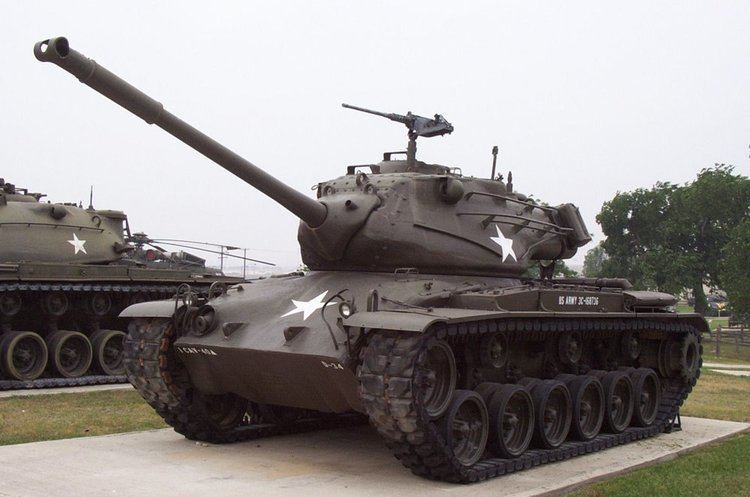In service 1952–early 1960s (USA) | Produced 1951–1953 | |
 | ||
Wars Suez Crisis, Indo-Pakistani War of 1965, Six Day War, 1971 Indo-Pakistani War, Turkish invasion of Cyprus, Ogaden War, Iran–Iraq War, Somali Civil War, Yugoslav Wars Manufacturer Detroit Arsenal Tank PlantAmerican Locomotive Co. | ||
The M47 Patton was a development of the M46 Patton tank mounting an updated turret, and was in turn further developed as the M48 Patton. It was the second American tank to be named after General George S. Patton, commander of the U.S. Third Army during World War II and one of the earliest American advocates of tanks in battle.
Contents
History
The M47 was the U.S. Army's and Marine Corps' primary tank, intended to replace the M46 Patton and M4 Sherman medium tanks. The M47 was widely used by U.S. Cold War allies, both SEATO and NATO countries, and was the only Patton series tank that never saw combat while in US service.
Although similar in appearance to the later M48s and M60s, these were completely new tank designs. Many different M47 Patton models remain in service internationally. The M47 was the last US tank to have a bow-mounted machine gun in the hull.
Design
Although a new power plant corrected the mobility and reliability problems of the M26 Pershing, the subsequently renamed M46 was considered a stopgap solution that would be replaced later by the T42 medium tank. However, after fighting erupted in Korea, the Army decided that it needed the new tank earlier than planned. It was deemed that there was not enough time to finish the development of the T42 and fix various problems that were likely to emerge in the new design. The final decision was to produce another interim solution, with the turret of the T42 mounted on the existing M46 hull. The composite tank, developed by the Detroit Arsenal, was named the M47 Patton and entered production in 1951. Its main gun was the M36 90 mm gun with an M12 optical rangefinder fitted. The secondary armament consisted of two .30 cal Browning machine guns, one in the bow and one coaxial with the 90mm main gun in the turret, and a .50cal Browning M2 on a pintle mount on the turret roof. The M47 was the last American-designed tank to include a bow machine gun. The T42 turret had a larger turret ring than the M26/M46 turret, and featured a needle-nose design, which improved armor protection of the turret front, an elongated turret bustle and storage bin which protruded halfway across the engine deck, and sloped sides to further improve ballistic protection; this gave the turret a decidedly lozenge-shaped profile. It also featured the M12 stereoscopic rangefinder, which was designed to improve first-round hit probability but proved difficult to use; the rangefinder protruded from both sides of the upper turret front, which would be a feature of American tanks until the advent of the M1 Abrams in 1980.
Production began at the Detroit Tank Arsenal in June 1951 before the M47 was standardized for production. Delays in the shipment of the M12 rangefinder and other problems due to the rushed production schedule caused a protracted testing period, and the first M47s were not fielded to the 1st and 2nd Armored Divisions until summer 1952. Standardized in May 1952, the M47 Patton's production ran until November 1953; Detroit built 5,481 tanks, and American Locomotive Company (Alco) produced 3,095, for a total production run of more than 9,000 M47 Pattons.
Deployment
With the arrival of the improved M48 Patton in 1953, the M47 was declared 'limited standard' in 1955, and examples in tank units were replaced with the M48 series soon after. After being declared obsolete in 1957, M46s and M47s were retained in active duty infantry division battlegroup assault gun platoons (four tanks each, one platoon per battlegroup, for a total of 20 tanks per division) until replaced with the light truck-mounted SS-10 anti-tank guided missile in the early 1960s. M47s were used by the Reserves for a relatively short time, soon being replaced by early production M48 Patton series tanks; thus, most of the M47s were exported in the late 1950s.
The US Marine Corps also fielded M47s starting in late 1952; after the Korean War, all seven Marine tank battalions, three divisional, two reserve training, and two force level, each fielded M47s. But these were soon replaced with M48A1 Pattons and M103 heavy tanks, with the last M47s being retired in 1959.
The M47 was widely used by many countries, especially NATO and SEATO allies, including Austria (147), Belgium (784), Ethiopia (30), France (856), Greece (396 from USA and West Germany), Iran (around 400), Italy (2,480), Japan (1 for evaluation only), Jordan (49), Pakistan (100), Portugal (161), Saudi Arabia (23 from the US, 108 on the international market), Somalia (25 from Saudi Arabia), South Korea (531), Sudan (17 from Saudi Arabia), Spain (389), Switzerland (2 for evaluation), Turkey (1,347 from the US and West Germany), West Germany (1,120), and Yugoslavia (319). Like the US Army of the time, the West German Bundeswehr also used some of their M47s as interim tank destroyers/assault guns until replaced by the Raketenjagdpanzer 1 tank destroyers armed with SS-11 anti-tank guided missiles in the early 1960s.
US Army M47s remaining in storage were expended as targets. In the 1970s, they were used for the M60A1's 105mm gun with devastating effect. The 105 mm HEAT round would penetrate the frontal armor with ease. Many M47s in like-new condition met their fate in this manner, showing the M60 crews first hand the effects of modern tank weapons on conventional steel armor.
Combat service
Variants
Additional equipment
